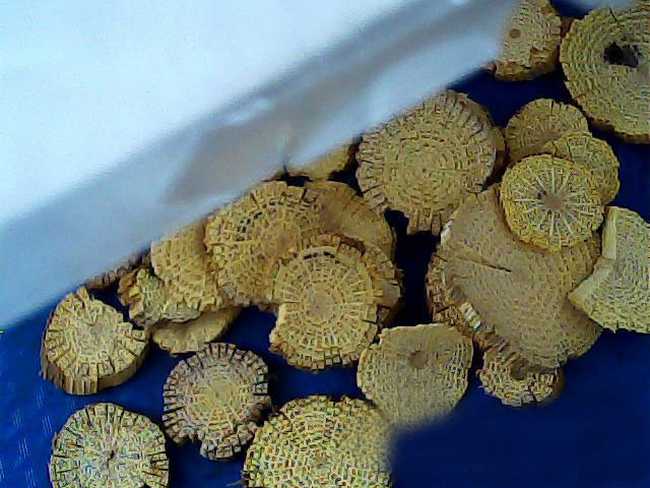There are a number of clematis vine varieties but medicinally it refers to the dried stems of Clematis armandii Franch. or Clematis montana Buch.-Ham. Both of them are the member of family Ranunculaceae. It is usually harvested during spring and autumn. In addition, it needs to remove the raw bark, dry in the sun, or slice the fresh vines before drying. By the way, clematis grows from seed or from cuttings.
Clematis montana is a perennial woody climbing plant, usually up to 8 meters in height. Stems are cylindrical and with longitudinal stripes; branchlets are pubescent and later become glabrescent when; the skin of old stems is peel off. Leaves are opposite or a few of them cluster with flower; petiole is 5 to 6cm; ternately compound leaf is ovate, broadly ovate or elliptic, 3-lobed, 2 to 7cm long, 1 to 5cm wide, and with acute or acuminate apex and serrated edge. Flowers are apetalous, bisexual, and 3 to 5cm in diameter and 1 to 6 of them cluster with leaves; sepals are 4, outstretched, oblong-obovate or obovate, 1.5 to 2.5cm long, 0.8 to 1.5cm wide; stamens are numerous, about 1cm long, and glabrous; carpel is many. Achene is flat, oval or oblong, 4 to 6mm long, glabrous, and with about 2.2cm feathery persistent style. Bloom time is from April to June and fruit time is from July to September.
CLEMATIS VINE HEALTH BENEFITS
Medicinally clematis and aristolochia manshuriensis are known for their excellent ability on inducing diuresis. That is the exact reason why the latter was heavily adulterated into some diet pills, which thus planted the seeds for the future tragedy. Now we already know that aristolochia plants contain a toxic ingredient called aristolochic acid, which causes human kidney damage or even death in long-term uses. Unlike aristolochia manshuriensis, clematis belongs to Ranunculaceae. That is to say, this herb has the same healing power but without the above-mentioned side effects. As a matter of fact, clematis and akebia quinata are taking over and becoming the substitute in all aristolochia manshuriensis based formulas for the treatment of a variety of diseases, such as Edema, stranguria, Amenorrhea, Arthralgia, oral ulcers, dysfunctional uterine bleeding, excessive vaginal discharge, urinary tract infections, genital warts, etc.
SAMPLE HERBAL FORMULAS RELATED CLEMATIS VINE
The Chinese Materia Medica believes that it is tasteless or slightly bitter in flavor and cold in nature. It goes to meridians of heart, small intestine, and bladder. Main functions are reducing fever, increasing secretion of urine, restoring menstrual flow, and promoting lactation. Basic clematis vine uses and indications include damp-heat uroschesis, edema, stranguria, tongue and mouth sores due to flaring heart-fire, damp-heat arthralgia, joint stiffness, amenorrhea, and blocked ducts during breastfeeding. Recommended dosage is from 3 to 6 grams in decoction.

Clematis Vine
1. Mu Tong San from Tai Ping Sheng Hui Fang (Taiping Holy Prescriptions for Universal Relief).
It is formulated with Chi Fu Ling, Ling Yang Jiao (Antelope Horns), Sheng Ma (Black Cohosh Rhizome), Da Huang (rhubarb), Mang Xiao (Glauber's Salt), etc. to heal Chronic Pharyngitis, chess tightness, and throat impediment.
2. Mu Tong Tang from Sheng Ji Zong Lu (Complete Record of Holy Benevolence).
It is combined with Zhong Ru Shi (Stalactite, Calcite), Lou Lu (Radix Rhapontici/Echinopsis), Gua Lou Gen (Trichosanthes Root), and Gan Cao (Licorice Root) to treat blocked ducts during breastfeeding.
3. Dao Chi San from Xiao Er Yao Zheng Zhi Jue (Key to the Therapeutics of Children's Diseases).
It is used together with Sheng Di Huang (Rehmannia), Gan Cao (Licorice Root), and Zhu Ye (Folium Bambusae) to treat infantile heart heat, which is manifested as difficulty and pain in micturition, red face, Mania, mouth sores, thirst, and so on.
4. Tong Cao Yin from Sheng Ji Zong Lu (Complete Record of Holy Benevolence).
It is designed with Sang Bai Pi (Mulberry Root Bark), Shi Wei (Pyrrosia Leaves), Chi Fu Ling (Sclerotium Poriae Cocos Rubrae), Fang Ji (Stephania Tetrandra), Ze Xie (Water Plantain Root), etc. to cure abdominal dropsy, and Borborygmus and big belly.

![Diseases, Symptoms, tcm, [tcmwindow.com]](/uploadFile/adImg/2015/11/11/f5cbfcc0-4df5-4646-9b9a-f316651a0199.jpg)





